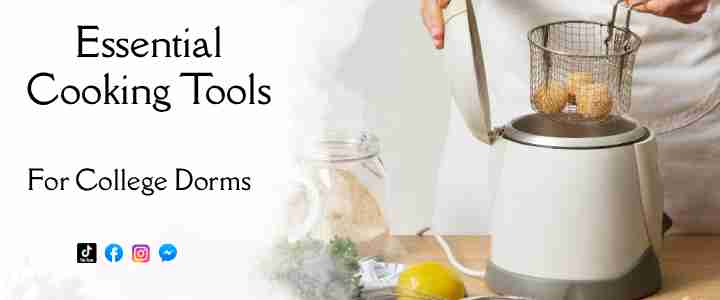Cooking Tools
Moving into a college dorm is exciting new friends, independence, and a space to call your own. But when hunger strikes, reality sets in: dorm kitchens (if they exist at all) are usually small, shared, and packed with rules. Most colleges restrict certain appliances for safety reasons, leaving students wondering, “What cooking tools am I actually allowed to bring?”
The good news is, you don’t need a full kitchen to prepare tasty and affordable meals. With the right cooking tools, you can keep yourself fueled, save money, and even impress your roommates all without breaking dorm policies.
Why Cooking Tools Matter in College
Relying on dining halls or takeout every day gets expensive quickly, not to mention unhealthy. Having a few key tools in your dorm:
- Saves money, groceries are cheaper than daily fast food.
- Encourages healthier eating, you control what goes into your meals.
- Adds convenience, no need to walk across campus for every snack.
- Builds independence, cooking is a life skill you’ll use long after graduation.
Cooking Tools Typically Allowed in Dorms
Most colleges publish a list of permitted appliances, but in general, the following are safe bets:
1. Mini Fridge

Almost every dorm allows mini fridges, and they’re a lifesaver. Perfect for storing leftovers, fresh fruit, or prepped meals. Pro tip: split the fridge with your roommate to save space and costs.
2. Microwave

Microwaves are usually dorm-approved and incredibly versatile. From reheating pizza to steaming vegetables or even baking a mug cake, it’s the go-to tool for quick student meals.

An electric kettle is a game-changer. Besides boiling water for tea or instant noodles, you can use it to make oatmeal, hard-boiled eggs, or even quick soups. It’s compact, fast, and energy-efficient.
4. Blender or Personal Smoothie Maker

Compact blenders (like personal-sized smoothie makers) are often allowed. They’re perfect for making fruit smoothies, protein shakes, or even pancake batter in minutes.
5. Rice Cooker

Some dorms allow small rice cookers, and if yours does, grab one. Beyond rice, you can cook pasta, steam vegetables, or even make stews. It’s a versatile tool that saves both money and time.
Tools That Are Usually Restricted
To avoid fire hazards, most dorms restrict:
- Hot plates and open burners
- Toasters and toaster ovens
- Deep fryers
- Crockpots or slow cookers (depending on the policy)
Always double-check your school’s housing handbook. Getting caught with banned appliances could lead to confiscation or worse, fines.
Smart Alternatives for Dorm-Friendly Cooking
If you can’t bring certain appliances, get creative:
- Microwave steam bags for veggies or rice are quick and mess-free.
- Collapsible food containers keep leftovers organized without wasting space.
- Mug meals (omelets, cakes, pasta) are perfect for microwave-only dorms.
- Pre-cut frozen veggies save prep time and fit perfectly into small freezers.
Tips for Making the Most of Limited Tools
1. Plan Simple Meals
Think three ingredients or less. For example, microwave rice, pre-cooked chicken, and frozen veggies make a full meal in minutes.
2. Share with Roommates
Coordinate with roommates so you don’t end up with two fridges or three kettles. Sharing reduces clutter and makes cooking more social.
3. Keep It Clean
Dorm rooms are tight, and messes pile up fast. Wipe down tools after every use and store them neatly. A cube organizer or small shelf works wonders for keeping things tidy.
Emily, a sophomore living in a dorm with strict rules, survived her first year using just a microwave, mini fridge, and electric kettle. “At first I thought I’d miss real cooking,” she says, “but I learned to get creative. I make oatmeal for breakfast, microwave quesadillas for lunch, and even steam veggies in my kettle for dinner. It’s not fancy, but it works and I save a ton compared to my friends who order takeout every night.”
Conclusion
Cooking in a college dorm doesn’t mean sacrificing good food. With a few essential cooking tools like a microwave, electric kettle, or compact blender you can prepare meals that are quick, affordable, and surprisingly tasty.
Before you pack, always check your dorm’s rules, then plan your toolkit around what’s allowed. Once you master the basics, you’ll realize that cooking in a dorm isn’t just about eating it’s about learning independence, saving money, and even creating moments with friends around shared meals.
So, what’s your must-have cooking tool for dorm life? Share your thoughts, or better yet, try one of these ideas and make dorm dining your own.



